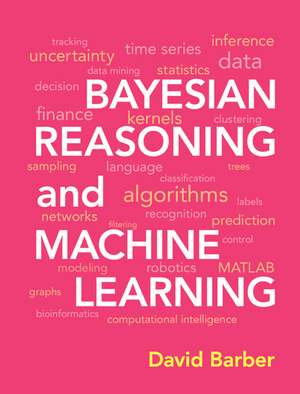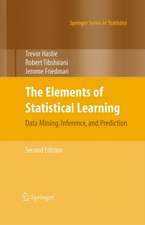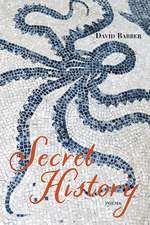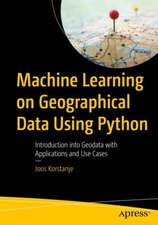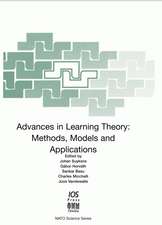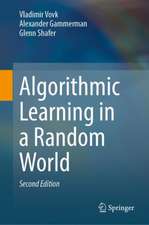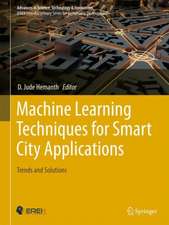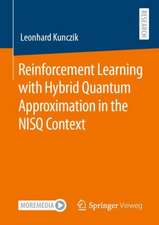Bayesian Reasoning and Machine Learning
Autor David Barberen Limba Engleză Hardback – feb 2012
Preț: 452.52 lei
Preț vechi: 565.65 lei
-20% Nou
Puncte Express: 679
Preț estimativ în valută:
86.59€ • 90.65$ • 71.65£
86.59€ • 90.65$ • 71.65£
Carte disponibilă
Livrare economică 15-29 martie
Livrare express 04-08 martie pentru 70.98 lei
Preluare comenzi: 021 569.72.76
Specificații
ISBN-13: 9780521518147
ISBN-10: 0521518148
Pagini: 735
Ilustrații: 287 b/w illus. 1 table 260 exercises
Dimensiuni: 193 x 251 x 37 mm
Greutate: 1.72 kg
Editura: Cambridge University Press
Colecția Cambridge University Press
Locul publicării:Cambridge, United Kingdom
ISBN-10: 0521518148
Pagini: 735
Ilustrații: 287 b/w illus. 1 table 260 exercises
Dimensiuni: 193 x 251 x 37 mm
Greutate: 1.72 kg
Editura: Cambridge University Press
Colecția Cambridge University Press
Locul publicării:Cambridge, United Kingdom
Cuprins
Preface; Part I. Inference in Probabilistic Models: 1. Probabilistic reasoning; 2. Basic graph concepts; 3. Belief networks; 4. Graphical models; 5. Efficient inference in trees; 6. The junction tree algorithm; 7. Making decisions; Part II. Learning in Probabilistic Models: 8. Statistics for machine learning; 9. Learning as inference; 10. Naive Bayes; 11. Learning with hidden variables; 12. Bayesian model selection; Part III. Machine Learning: 13. Machine learning concepts; 14. Nearest neighbour classification; 15. Unsupervised linear dimension reduction; 16. Supervised linear dimension reduction; 17. Linear models; 18. Bayesian linear models; 19. Gaussian processes; 20. Mixture models; 21. Latent linear models; 22. Latent ability models; Part IV. Dynamical Models: 23. Discrete-state Markov models; 24. Continuous-state Markov models; 25. Switching linear dynamical systems; 26. Distributed computation; Part V. Approximate Inference: 27. Sampling; 28. Deterministic approximate inference; Appendix. Background mathematics; Bibliography; Index.
Recenzii
'This book is an exciting addition to the literature on machine learning and graphical models. What makes it unique and interesting is that it provides a unified treatment of machine learning and related fields through graphical models, a framework of growing importance and popularity. Another feature of this book lies in its smooth transition from traditional artificial intelligence to modern machine learning. The book is well-written and truly pleasant to read. I believe that it will appeal to students and researchers with or without a solid mathematical background.' Zheng-Hua Tan, Aalborg University, Denmark
'With approachable text, examples, exercises, guidelines for teachers, a MATLAB toolbox and an accompanying website, Bayesian Reasoning and Machine Learning by David Barber provides everything needed for your machine learning course. Only students not included.' Jaakko Hollmén, Aalto University
'The chapters on graphical models form one of the clearest and most concise presentations I have seen … The exposition throughout uses numerous diagrams and examples, and the book comes with an extensive software toolbox - these will be immensely helpful for students and educators. It's also a great resource for self-study.' Arindam Banerjee, University of Minnesota
'I repeatedly get unsolicited comments from my students that the contents of this book have been very valuable in developing their understanding of machine learning … My students praise this book because it is both coherent and practical, and because it makes fewer assumptions regarding the reader's statistical knowledge and confidence than many books in the field.' Amos Storkey, University of Edinburgh
'With approachable text, examples, exercises, guidelines for teachers, a MATLAB toolbox and an accompanying website, Bayesian Reasoning and Machine Learning by David Barber provides everything needed for your machine learning course. Only students not included.' Jaakko Hollmén, Aalto University
'The chapters on graphical models form one of the clearest and most concise presentations I have seen … The exposition throughout uses numerous diagrams and examples, and the book comes with an extensive software toolbox - these will be immensely helpful for students and educators. It's also a great resource for self-study.' Arindam Banerjee, University of Minnesota
'I repeatedly get unsolicited comments from my students that the contents of this book have been very valuable in developing their understanding of machine learning … My students praise this book because it is both coherent and practical, and because it makes fewer assumptions regarding the reader's statistical knowledge and confidence than many books in the field.' Amos Storkey, University of Edinburgh
Notă biografică
Descriere
A practical introduction perfect for final-year undergraduate and graduate students without a solid background in linear algebra and calculus.
